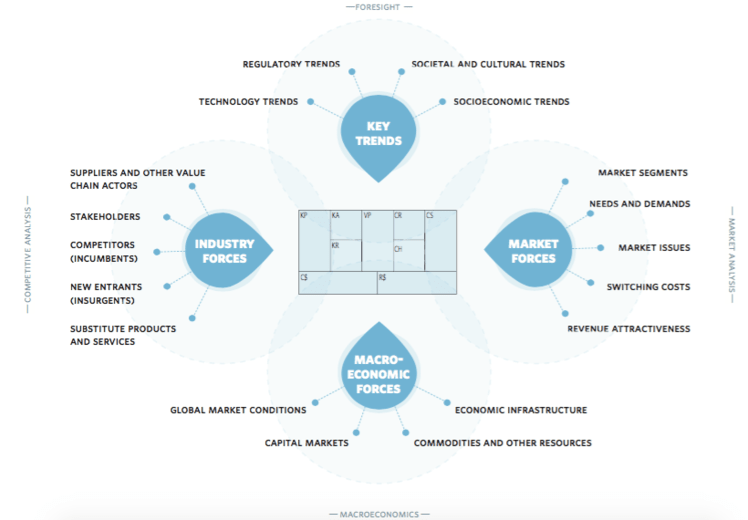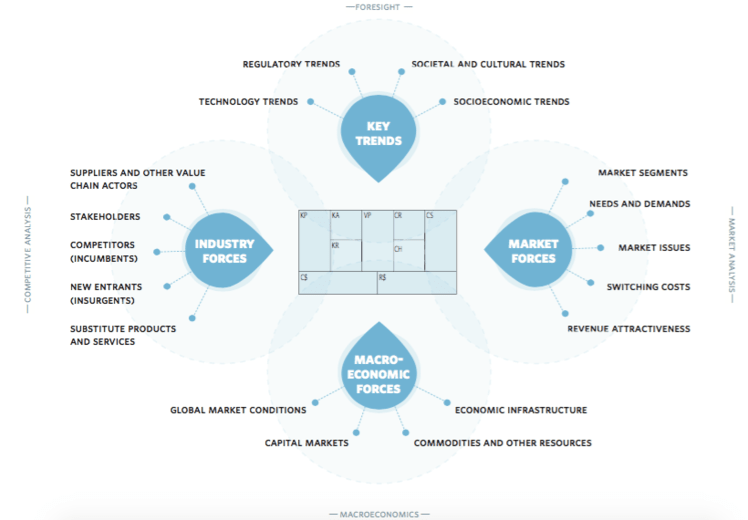BMC Part Sixteen: The Business Model Environment
Image Credit: Strategyzer (www.strategyzer.com)
(If you’re using the Canvas, you’ll love my free Business Modelling eBook, full of tips for inventing and testing ideas that will change the world)
An idea is not simply good or bad, it usually depends on the context.
For example, you may have dreamed up a version of Uber ten years ago, but without 4G internet, smartphones and the “Sharing Economy” movement, your idea wouldn’t have gone very far.
Our model might be fantastic on paper, but inappropriate for our context today.
To explore this in more detail, we look at the Business Model Environment.
This describes four factors that we can’t control, but which can help or hinder our idea.
They are:
Industry Forces – Other businesses who offer similar value propositions to similar customers. These could be existing competitors, new entrants or substitutes.
Key Trends – the evolving parameters of the law, culture and technology, which may change whether an idea is possible or acceptable.
Market Forces – our constantly changing customer segment and their expectations.
Macro-Economic Forces – The financial health of society and each person in it.
This affects our customers’ willingness and ability to pay for different things.
Let’s look at each of them in more detail…
Industry Forces
They say Scottie Pippen would have been the best basketball player in the world – except Michael Jordan played at the same time.
That’s the great tragedy – something can be both fantastic and completely overshadowed.
As entrepreneurs, we need to be aware of our competitors – not so that we can control them, but so that we avoid engaging in a losing battle.
If our product or service will be comprehensively defeated, then let’s go elsewhere.
This is also known as moving away from a “Red Ocean” to a “Blue Ocean”.
It’s also worth exploring the barriers to entry within an industry – some are prohibitively expensive to enter, like making semiconductors, cars or phone towers.
That means there will be a few strong players who are hard to beat.
Alternatively, starting your own catering business or fashion label requires a smaller investment, but that also means there will be a large number of others who are doing the same thing.
The trick here seems to be in understanding our competitive advantage (the area where our competitors can’t keep up) and pushing this advantage as hard as we can.
Some brands have the advantage of being cool, or innovative, or rebellious, or cheap, or ethically conscious, or funny, or well designed, or specialist, or exotic, or patriotic.
Generally speaking, every major brand collapse you can think of started with the abandonment of their competitive advantage.
Kodak invented digital cameras, then neglected the technology.
Department stores thrived on convenience, but their disdain for internet shopping made their services harder to engage with.
Nokia and Motorola had the phone market sewn up, then sat on their hands as two others took their Innovative reputation away.
Key Trends
In Australia, we’ve recently had controversy over the popularity of Uber.
Our government sold limited numbers of taxi licenses (which were going for over $500,000 each in 2011), and suddenly they’re worthless.
The taxi industry chose to ignore the power of smartphones, by which customers could track their ride, pay without cash, rate their driver, etc.
When a new alternative presented itself, customers voted with their wallets and switched to Uber.
The taxis thought the law would protect them, and they were wrong.
The government chose not to outlaw Uber, and so a giant industry has suddenly become much more competitive.
This is the power of social, technological and political trends – irreversible progress and change that can affect business models in sudden and occasionally unpleasant ways.
Technology enabled Napster to thrive, and political pressure shut it down.
4G mobile internet has changed how customers use their phones.
Automation is eliminating entire fields of work, and creating new ones in the process
Copyright law is changing how businesses innovate, and new precedents are being set each month.
Good entrepreneurs stay up to date with culture, the law and the possibilities presented by technological developments.
If they don’t, their competitors certainly will.
Market Forces
Customer segments are not set in stone.
Think of your favourite brands - are they the same as they were 5 years ago?
10 years ago?
Our customers will change over time – partly because their needs will change, and partly because their attitudes will change.
There’s another way of looking at this – new types of customers with new needs will emerge, and there is an opportunity to create a model that delights them.
A great example of this is the selfie stick – mocked for being uncool, yet countless millions have been sold in the past five years.
That’s because customers suddenly had a high definition camera on them at all times, and social media accounts that let them share their lives with the world.
Or look at the demand for gluten free foods – what used to be an obscure health requirement is suddenly ubiquitous, and the gluten free customer segment increased exponentially.
The question is, what needs are currently going unsatisfied?
Which groups of customers haven’t found a brand that understands them?
Macro-Economic Forces
Customers are constantly thinking about their money – and emotion tends to trump reason. Sometimes we’re fearful, sometimes we’re optimistic.
Sometimes we want to be conservative, sometimes we want to show our wealth/success.
Entrepreneurs need to understand how the economy will affect our customer’s decision making. In other words, we need to sense their mood and tailor our model to match their wallets.
For example, many of the world’s largest countries (e.g. China) are rapidly developing a “middle class”, who are suddenly able to afford to travel and buy their first a car.
Simultaneously, house prices and slow wage growth will pinch young people in Australia, which in turn affects their spending.
It’s important to note that these factors aren’t on the Business Model Canvas because they’re not things that you can control.
The canvas is about areas that can be designed and altered, things you’re able to influence.
This framework is important, because it reminds us to look out the window every so often.
It’s like checking the weather – you can’t change it, but you can dress for it.
By constantly staying up to date with forecasts, you avoid being caught out in a storm.
I once had a social entrepreneur look at the Business Model Environment and declared: “Well there’s no way I can know all of that!”
Well, maybe they shouldn’t run a startup.
It’s your job to be up to date with your industry and your customers.
Because what’s your alternative?
Hope that the world doesn’t change while you build your business?
Again, if there’s trouble brewing, we want to know EARLY so that we can design around it.
Bad news is ok; it’ll make you feel flat for a week but then you’ll work around it.
What we don’t want is to massively invest in something that is suddenly obsolete – when we could have read the warning signs.
Take some time to map out your Environment.
The worst that can happen is that this proves that you’re totally across your industry.
But more likely, it might prompt some good ideas, or eliminate some bad ones.
Next, we're looking at the best ways of Pitching your model...
This is a multi-part series on the Business Model Canvas.
If you’d like to jump straight to a particular section, go to:
Overview: How To Use The Business Model Canvas
Desirability: Customer Segments, Value Proposition, Customer Relationships, Channels
Feasibility: Key Resources, Key Activities, Key Partners
Viability: Cost Structure, Revenue Streams
Then once you've made your first Canvas:
Reviewing: After Your First Model, Alarm Bells
Reinventing: Testing, What If?
Improving: Metrics, The Business Model Environment
Extensions: Pitching, Social Impact, Making It Great, What Next?













